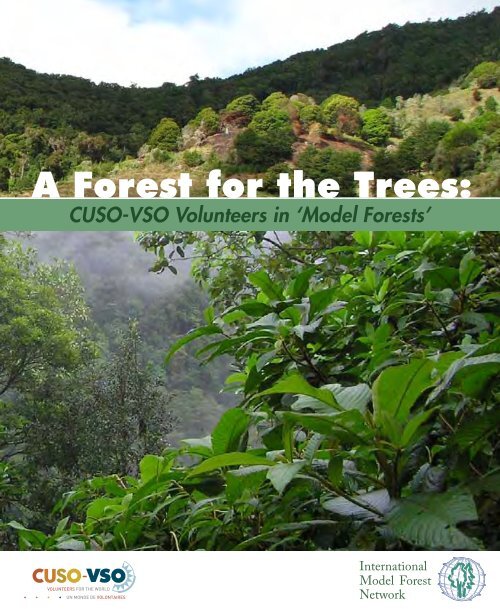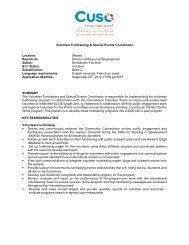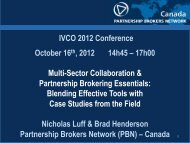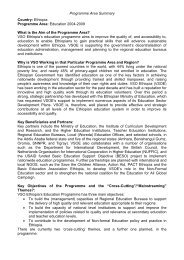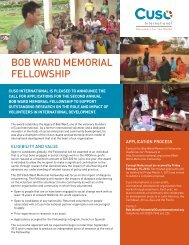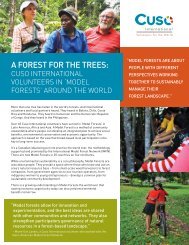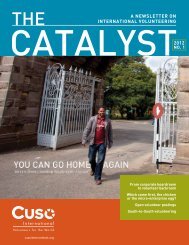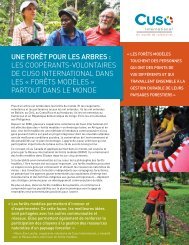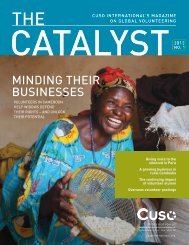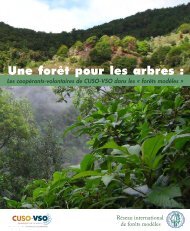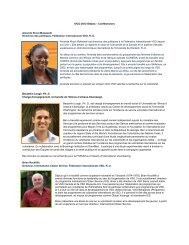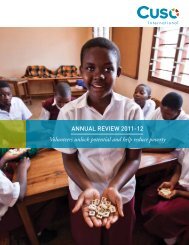model forest - Cuso International
model forest - Cuso International
model forest - Cuso International
- No tags were found...
You also want an ePaper? Increase the reach of your titles
YUMPU automatically turns print PDFs into web optimized ePapers that Google loves.
A Forest for the Trees:<br />
CUSO-VSO Volunteers in ‘Model Forests’
For information on how to volunteer with CUSO-VSO, please visit www.cuso-vso.org
A tree fell<br />
in the <strong>forest</strong>…<br />
More than one tree has fallen in the world’s<br />
<strong>forest</strong>s, but many people have heard. They<br />
heard in Canada. They heard in Bolivia, Costa<br />
Rica and Honduras. They heard in Cameroon and<br />
the Philippines.<br />
And they heard in Araucanía, Chile, a mountainous<br />
area that borders Argentina. The Mapuche-Pehuenche<br />
indigenous people live in this culturally diverse<br />
slice of the Andes, along with settlers of European<br />
ancestry native to the region. Farming, logging and<br />
livestock ranching are how most of the nearly 30,000<br />
inhabitants make a living.<br />
But it’s not an easy life – the geography is steep and<br />
rough, the climate harsh. And the soils and the <strong>forest</strong>s<br />
have been weakened by questionable farming and<br />
logging practices.<br />
That’s why a different kind of natural resource<br />
management has taken root in the Araucanía region.<br />
It’s called a <strong>model</strong> <strong>forest</strong>, a form of community<br />
stewardship that provides both a place and a process<br />
where best practices are developed, tested and<br />
improved. These <strong>model</strong>s of sustainability are then<br />
shared with other communities.<br />
It’s a Canadian idea being put into practice the world<br />
over, the methodology supported and promoted by the<br />
<strong>International</strong> Model Forest Network (IMFN). There are<br />
now <strong>model</strong> <strong>forest</strong>s in 24 countries on five continents.<br />
While environmental sustainability is a core<br />
philosophy, <strong>model</strong> <strong>forest</strong>s are also about people. They<br />
provide a space where those who know and use an<br />
area’s natural resource base – from small-scale wood<br />
harvesters to <strong>forest</strong> companies, from government<br />
agencies to tourism operators – develop a common<br />
plan to achieve social benefits, environmental<br />
conservation, and economic opportunity.<br />
The ‘Alto Malleco’ Model Forest in the Araucanía<br />
region of Chile is spread over roughly 400,000<br />
hectares of landscape. It covers not only native<br />
<strong>forest</strong>s but also steppes (barren plains), watersheds,<br />
grasslands, scrublands, snow-capped mountains and<br />
even a few glaciers. The region is home to the native<br />
araucaria tree (often called the ‘monkey puzzle<br />
tree’), a slow-growing, cedar-type conifer. There are<br />
three national wildlife reserves and one national<br />
park in the area.<br />
Partners in the Alto Malleco Model Forest include the<br />
Chilean national government, municipal government,<br />
farmers, indigenous people, community development<br />
groups, and representatives of agricultural and <strong>forest</strong>ry<br />
industries.<br />
Results to date include the bringing together of<br />
different stakeholders – including small-scale and<br />
indigenous landowners – to develop a strategic plan,<br />
as well as the development of projects in sustainable<br />
<strong>forest</strong>ry, soil recovery, inter-cultural communication<br />
and environmental education. There has also been<br />
a renewed emphasis on the harvesting of non-timber<br />
<strong>forest</strong> products; for example, an edible kernel that is<br />
gathered from the araucaria tree.<br />
There is a growing understanding in the Araucanía<br />
region – and in <strong>model</strong> <strong>forest</strong>s the world over – that<br />
sowing economic opportunity in the present can also<br />
yield environmental benefits in the future.
“Model <strong>forest</strong>s allow for innovation and<br />
experimentation, and the best ideas<br />
are shared with other communities<br />
and networks. They also strengthen<br />
participatory governance of natural<br />
resources in a <strong>forest</strong>-based landscape.”<br />
– Marie-Eve Landry, a CUSO-VSO volunteer<br />
who worked with the Iberoamerican Model<br />
Forest Network.
And these<br />
volunteers heard...<br />
The <strong>model</strong> <strong>forest</strong> method was successfully transplanted<br />
from Canada to the Americas – and now to Africa<br />
and Asia – and CUSO-VSO volunteers helped it take<br />
root. Sylvain Legault of Gatineau, Quebec, was the first<br />
volunteer placed with a <strong>model</strong> <strong>forest</strong> in the region – he<br />
was on the island of Chiloé, lying off the southern coast of<br />
Chile, from 2000 to 2002.<br />
Measuring 180 by 50 kilometres, the island is home<br />
to both diverse ecosystems and unique human cultures.<br />
Once carpeted almost entirely in trees, only 50 percent of<br />
Chiloé’s temperate rain<strong>forest</strong> remains. Chiloé has a mild,<br />
cool climate, so most wood goes to domestic heating and<br />
cooking – unlike mainland Chile, which exports shiploads<br />
of lumber and pulp. Most of the island’s 150,000 citizens<br />
are small landholders who farm, fish and log to survive.<br />
Without proper management, the remaining woodlands<br />
would be chipped away.<br />
A sustainable approach to <strong>forest</strong>ry and natural resource<br />
management was needed, and Legault helped the<br />
member partners of the Chiloé Model Forest map the<br />
island’s resources. He also assisted with strategic plans<br />
and projects. In addition to more ecologically sound<br />
logging, new emphasis was placed on renewable nonwood<br />
products such as honey and hazelnuts, as well as<br />
eco-tourism. Other initiatives included an environmental<br />
education centre and a ‘biodiversity store’ where<br />
sustainably produced local handicrafts are sold.<br />
Many volunteers have followed in Legault’s footsteps by<br />
serving in these <strong>forest</strong>s of the Americas. In 2002, CUSO<br />
(now CUSO-VSO following the 2008 merger with VSO<br />
Canada) and the IMFN signed a partnership agreement,<br />
and to date 40 CUSO-VSO volunteers have supported the<br />
development and implementation of nine <strong>model</strong> <strong>forest</strong>s<br />
throughout the Americas.<br />
And volunteers have branched out across the ocean to<br />
Africa and Asia. CUSO-VSO is now working with the<br />
IMFN and the African Model Forest Network on two<br />
<strong>model</strong> <strong>forest</strong>s in Cameroon. Volunteers are serving with<br />
local governments and civil society groups in the Campo<br />
Ma’an and Dja et Mpomo Model Forests.<br />
In the Philippines, volunteers are working with local<br />
partner groups in the Ulot and Carood watershed<br />
Model Forests.<br />
CUSO-VSO and the IMFN are helping the many<br />
stakeholder groups in these <strong>forest</strong>s develop a<br />
management <strong>model</strong> of the landscape and its resources<br />
that is sustainable in all senses of the word –<br />
ecologically, socially, economically and culturally.
CUSO-VSO Volunteers in Model Forests, Past and Present<br />
Here are snapshots of just a few of the CUSO-VSO volunteers who have<br />
worked – or are working now – with <strong>model</strong> <strong>forest</strong>s the world over.<br />
While most volunteers have come from Canada, some have been recruited<br />
from within the country in question, or from other developing nations.<br />
Marie-Eve Landry Bob Sutton<br />
Linda Vaillancourt Robert Friberg<br />
Réal Bonneville<br />
Fernando Carrera<br />
Milka Barriga<br />
Ulysse Rémillard<br />
Jacqueline Martínez<br />
Miriam Stein<br />
Jean-Marie Johnston & Diane Cantin-Johnston,<br />
with Abwe Was Masabo Munyonge
Marie-Eve Landry of Saint-Bruno, Québec, volunteered in Costa Rica.<br />
She worked on project management and research with the management<br />
team of the Iberoamerican Model Forest Network, which links 25 <strong>forest</strong>s<br />
in 13 Spanish and Portuguese-speaking countries.
Bob Sutton, from Marcelin, Saskatchewan, served in<br />
Honduras. He volunteered as a sustainable natural resource<br />
management advisor to the Atlántida Model Forest and its<br />
member partner organizations.
Linda Vaillancourt of Wotton, Québec, was in Costa Rica. She is a protected areas specialist who<br />
volunteered with the Reventazón Model Forest. Linda assisted in the participatory development of<br />
management plans.
Robert Friberg, who hails from Kaleden, British Columbia, volunteered in Chile. He offered support<br />
and advice to the National Forestry Corporation, which is the government institution responsible for all<br />
Chilean <strong>model</strong> <strong>forest</strong>s.
The Roots of the Model Forest Movement<br />
<strong>model</strong> <strong>forest</strong> is a place where natural resource<br />
A management best practices are developed, tested,<br />
improved, and shared as <strong>model</strong>s of sustainability.<br />
Geographically, such a site must encompass an area<br />
large enough to represent all of the <strong>forest</strong>’s uses and<br />
values. It’s a working landscape of protected areas,<br />
farms, woodlots, towns, watersheds and rivers.<br />
Model <strong>forest</strong>s provide a space where those who know<br />
and use woodlands can develop a common plan to<br />
achieve social benefits, environmental conservation,<br />
and economic opportunity. The approach is based on<br />
the view that broad-based local participation is the<br />
key to long-term success.<br />
At the heart of each independent <strong>model</strong> <strong>forest</strong> is a<br />
group of people who have different perspectives on<br />
the human and natural dynamics within their <strong>forest</strong>based<br />
ecosystem – viewpoints that are all necessary<br />
to make informed, balanced and fair decisions about<br />
how to manage the <strong>forest</strong> and its resources.<br />
That participation could include woodlot<br />
owners, small-scale food harvesters, <strong>forest</strong><br />
companies, indigenous peoples, farmers, park<br />
staff, environmentalists, researchers, community<br />
development groups, government agencies, tourism<br />
operators, hunters & trappers…all integrating their<br />
own interests into the common good. Each <strong>model</strong><br />
<strong>forest</strong> organization is largely dependent on volunteer<br />
energy and expertise.<br />
No two <strong>model</strong> <strong>forest</strong>s are identical. Some are in<br />
low population-density areas, where rural poverty<br />
and access to resources are priority issues. Other<br />
<strong>model</strong> <strong>forest</strong>s may be in heavily settled areas where<br />
urban-rural issues, including water quality, recreation,<br />
conservation and biodiversity, feature prominently in<br />
the equation for sustainable <strong>forest</strong> management.<br />
The approach was first brought to the world’s<br />
attention at the 1992 United Nations Conference on<br />
Environment and Development, held in Rio de Janeiro,<br />
Brazil. At this global gathering, better known as the<br />
Earth Summit, Canada promised to “internationalize”<br />
its innovative <strong>model</strong> <strong>forest</strong> program.
“A <strong>model</strong> <strong>forest</strong>…is a process and a journey<br />
as people plan, implement and participate in<br />
projects and activities to achieve their vision.<br />
I have been privileged to live, work and learn<br />
alongside my peers here in Honduras, and to<br />
join them for part of that journey.”<br />
– Bob Sutton, a volunteer who worked with the Atlántida<br />
Model Forest in Honduras.<br />
What began with an initial 10 sites in Canada<br />
has grown to more than 55 <strong>model</strong> <strong>forest</strong>s in 24<br />
countries on five continents. Collectively, these sites<br />
make up the <strong>International</strong> Model Forest Network<br />
(IMFN). To support these efforts, the IMFN Secretariat<br />
was established in 1995. Based in Ottawa in the<br />
Canadian Forest Service of Natural Resources<br />
Canada, the Secretariat provides the day-to-day<br />
coordination of support and development services to<br />
<strong>model</strong> <strong>forest</strong>s worldwide.<br />
The IMFN plants the seed of the <strong>model</strong> <strong>forest</strong> idea,<br />
and then harvests the collective experience and<br />
lessons learned from each site into services that<br />
help new ventures take root – and existing ones<br />
grow better.<br />
For more information on <strong>model</strong> <strong>forest</strong>s the world over,<br />
visit www.imfn.net
Réal Bonneville, who comes from Cowansville, Québec,<br />
volunteered in Honduras. He helped develop the Yoro Model<br />
Forest. Réal worked with <strong>forest</strong> landowners, communities and<br />
local organizations to create a strategic vision, set up a board<br />
of directors, and prepare proposals and project plans.
Fernando Carrera is from Lima, Peru, and was a ‘South-South’ CUSO-<br />
VSO volunteer. He served in Costa Rica offering managerial, research<br />
and technical support to the Iberoamerican Model Forest Network.
Milka Barriga originates from La Paz in Bolivia, and was another South-South volunteer working in<br />
<strong>model</strong> <strong>forest</strong>s. She is an economist with research experience in land use systems, and provided advice on<br />
collaborative environmental management to the Iberoamerican Model Forest Network.
Ulysse Rémillard’s home is Las Laurentides, Québec, and he volunteered in Bolivia. Ulysse worked<br />
in the Chiquitano Model Forest on management of natural resources, indigenous territories zoning, and<br />
training in non-wood <strong>forest</strong> products.
Miriam Stein of Montreal, Quebec, is working with the Campo Ma’an Model Forest in Cameroon.<br />
She is an Organizational Development Advisor, helping to build capacity of the Network of Rural<br />
Women enabling those living in the <strong>forest</strong> to develop sustainable income generating projects.
Jean-Marie Johnston (left) and Diane Cantin-Johnston (centre) of Quebec City, Quebec are<br />
volunteering in the Campo Ma’an Model Forest in Cameroon. As Organizational Development Advisors,<br />
they are respectively developing the institutional capacity of the Network of Community Forest Enterprises<br />
and the Network of Local NGOs.<br />
Abwe Was Masabo Munyonge (right) is Canadian of Zairian origin, and lives in<br />
Edmundston, New-Brunswick. He is also volunteering in Cameroon as an Organizational<br />
Development Advisor to support the institutional and management capacity of the Executive<br />
Secretariat of the Campo Ma’an Model Forest.
Jacqueline Martínez is originally from Colombia, but now calls Verdun,<br />
Québec home. The biologist worked in Costa Rica offering her technical<br />
expertise in environmental management to the Federation of Municipalities of<br />
Cartago, a board member of the Reventazón Model Forest.
CUSO-VSO takes a walk in the woods<br />
Since CUSO-VSO’s first volunteer took a walk in<br />
the woods of the Chiloé <strong>model</strong> <strong>forest</strong> in Chile,<br />
many more volunteers have served in <strong>model</strong> <strong>forest</strong>s<br />
around the world<br />
CUSO-VSO is an international development civil<br />
society agency that works through volunteers.<br />
Each year, we place hundreds of volunteers who<br />
collaborate on development projects in Latin<br />
America, the Caribbean, Africa and Asia.<br />
We were created in 2008 from the merger of CUSO<br />
and VSO Canada, two agencies with decades of<br />
experience in volunteer-sending. CUSO was founded<br />
in 1961, originally as Canadian University Service<br />
Overseas. Voluntary Service Overseas Canada<br />
started in 1995. Combined, CUSO-VSO has now<br />
placed over 15,000 volunteers. We are the North<br />
American member of VSO <strong>International</strong>, a worldwide<br />
alliance of Voluntary Service Organizations.<br />
One of CUSO-VSO’s focus areas is sustainable<br />
natural resource use – the organization understands<br />
that long-term, healthy development depends on a<br />
healthy environment. CUSO-VSO and its partners are<br />
improving the capacity of local communities to better<br />
protect their natural resources.<br />
And CUSO-VSO’s work with IMFN has moved beyond<br />
the borders of the Americas. There are now <strong>model</strong><br />
<strong>forest</strong>s in Cameroon and the Philippines.<br />
This CUSO-VSO/IMFN partnership has grown strong<br />
through the lessons learned by the volunteers working<br />
at the <strong>forest</strong>s’ grassroots.<br />
For more information on CUSO-VSO and how to<br />
volunteer abroad, visit www.cuso-vso.org<br />
Through this international network, we build<br />
partnerships with groups that benefit people living in<br />
developing communities. Our volunteers come from<br />
many professional and personal backgrounds, and<br />
from across Canada and the United States. They are<br />
united in the desire to use their skills and professional<br />
experience to help overcome poverty in more than<br />
40 countries around the world.
Members of the Atlántida Model Forest in Honduras putting up signs protecting<br />
the “El Nacimiento” micro watershed. The catchment area and springs that flow<br />
from El Nacimiento are the main source of water for the community of Tarritos.<br />
Posting signs about the importance of <strong>forest</strong> and watershed management is a<br />
common activity in many <strong>model</strong> <strong>forest</strong>s.
Pictured here are:<br />
Cesara Zavala, Angel Sandres, Joaquin Canales, Mirna Perdomo, Erick Duran, Lili Acosta,<br />
Orlando Polanco, Roni Castro, Gerardo Navarro, Armando Miralda and Ovilio Orellana.


